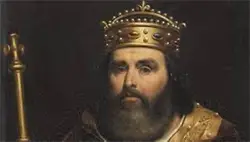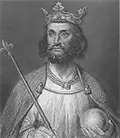The Carolingians
Part 2: France and Germany, Back and Forth In the Western Kingdom reigned Charles II, known as Charles the Bald. His brother Louis invaded in 858 and Charles nearly lost his kingdom. The two brothers fought each other as well when their brother Lothair died and eventually agreed to a division of his land. Charles had to contend with invasions from Brittany and from Vikings, who had sacked Paris in 845 and nearly took it again 40 years later. 
Pope John VIII crowned Charles the Bald as emperor in 875. His brother Louis, thinking himself a better candidate for the crown, invaded the Western Kingdom, forcing Charles to defend his realm on the field of battle. Louis the German died in 876, and Charles attempted to return the favor by invading the Eastern Kingdom. He was defeated. Beset by yet another German invasion and a Saracen invasion of Italy, Charles died on campaign, in the Alps, in 877. After another sole ruler (Charles's son, Louis the Stammerer) and a shared rule (Louis's sons Louis III and Carloman II), the Western Kingdom was part of a united empire, under Charles the Fat (left). The son of Louis the German, he was the last to rule over all of what Charlemagne had created. The united empire lasted six years (881–887) and was then divided again, this time into five kingdoms. 
Succeeding Charles the Fat as King of the West Franks was Odo. He had been the Count of Paris and, after Charles the Fat was deposed, was elected as the West Frankish leader. Odo was the first king in the line of Robert the Strong, a powerful man who had a large amount of land and several titles to this name and also defended his land valiantly against an increasing number of Viking invasions. He died in one such battle in 866. Odo carried on in his father's wake, keeping them from taking Paris in a great siege in 885. It was this success, along with his bloodline, that convinced the Western Frankish nobles to declare Odo their king. He was crowned in 888. Odo ruled for a decade. For the last half of that, he battled with another young Frankish contender, another son of Louis the Stammerer who was known as Charles the Simple. Another group of nobles wanted Charles to their king and had opposed the rule of Charles the Fat. In 893, when Charles the Simple was just 14, these nobles crowned him their king. When Odo died in 898, the rest of the Western Frankish nobles agreed that Charles the Simple was their king. This was the ruler who confronted the group of Vikings who besieged Chartres and Paris in 911. Charles negotiated a peace with their leader, Rollo, (a peace that included Rollo's marrying Charles's daughter Gisela) and that was the creation of the Duchy of Normandy. One of the great supporters of Charles the Simple had been Robert, whose father was Robert the Strong and whose brother was Odo. The younger Robert had not chosen to contest Charles's assumption of the throne after Odo died. Indeed, Robert and Charles got along together quite well, and Robert had fought against the Vikings in 911. A decade later, the two men could not resolve their differences. Robert by this time had the backing of many powerful clergymen and nobles and, raising an army against Charles, drove him off the throne. Rollo came to Charles's aid and gave battle. Robert died in the fighting, but his forces captured Charles and kept him hostage. Frankish nobles again elected their king, choosing Robert's son-in-law, who became known as Rudolph of France. Rudolph's wife was Queen Emma. Her brother (and the son of Robert I) was Hugh, known as Hugh the Great, who became the most powerful man in France. Rudolph spent much of his reign defending it, from both Vikings and supporters of Charles the Simple. The king died after yet another battle, in 936. Next page > End of a Dynasty > Page 1, 2, 3 |
|
Social Studies for Kids
copyright 2002–2024
David White




